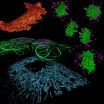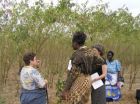Key to cleaner environment may be right beneath our feet
2013-02-17
(Press-News.org) UNIVERSITY PARK, Pa. -- While many people recognize that clean water and air are signs of a healthy ecosystem, most do not realize that a critical part of the environment is right beneath their feet, according to a Penn State hydrologist.
The ground plays an important role in maintaining a clean environment by serving as a natural water filtration and purification system, said Henry Lin, professor of hydropedology and soil hydrology. Understanding the components that make up this integral part of the ecosystem can lead to better groundwater management and smarter environmental policy.
"We look at nature and we see all the beauty and all the prosperity around us," said Lin, "But most people don't know or tend to forget that the key to sustainability is right underground."
Lin, who reports on his research today (Feb. 17) at the annual meeting of the American Association for the Advancement of Science in Boston, said that the earth's outer layer -- from the top vegetation canopy to the strata of soils and layers of underground material -- helps soak up and purify water by extracting excess nutrients, heavy metals and other impurities. The ground can also act as a storage container for freshwater.
About 60 percent of the world's annual precipitation ends up in this zone, Lin said.
"In fact, there is more water under the ground than there is in the so-called 'blue waters,' such as lakes and rivers," said Lin.
Besides using freshwater for drinking, people use large amounts of water to irrigate agricultural fields and as part of industrial operations. The researcher said that just as a global green revolution raised awareness about food security, a "blue revolution" may lead to efforts to water security with clean, safe water supply around the globe.
"Without water there is no life," Lin said. "Without groundwater, there is no clean water."
Lin said that the system is currently under threat from poor land management practices that fail to consider how ground water is affected by land uses, such as new building projects, underground storage and agricultural operations. Planners should consider, for example, how the ground and plants in an area can affect water run-off. In some cases, not taking the ground and underground features of an area into consideration can lead to flooding, or to the addition of impurities into drinking water supplies.
Besides reaching out to managers and planners, Lin said that the general public also must become more aware of groundwater management issues.
"In a lot of cases, for the general public and even people from government agencies and funding agencies, it's out of sight, out of mind," Lin said. "But, beneath the surface lies the foundation of our sustainability."
### END
ELSE PRESS RELEASES FROM THIS DATE:
2013-02-17
February 17, 2013 – Boston, MA - As the National Football League braces for lawsuits by 4000 former players alleging the league failed to protect them from the long-term consequences of concussions, game-changing research by a leading Canadian researcher shows damage to the brain can persist for decades after the original head trauma.
"Even when you are symptom-free, your brain may still not be back to normal," says Dr. Maryse Lassonde, a neuropsychologist and the scientific director of the Quebec Nature and Technologies Granting Agency.
Lassonde, whose work is supported ...
2013-02-17
February 17, 2013 - Boston, MA – Northern communities are in the midst of a period of intense and rapid change brought on by modernization, industrialization and the realities of climate change. From preserving the means to hunt caribou to protecting stocks of arctic char - balancing development with a respect and preservation of traditional means of sustainability may be key to improving standards of living in the North.
With the help of the icebreaker Amundsen, Louis Fortier, Canada Research Chair on the Response of Arctic Marine Ecosystems to Climate Change and other ...
2013-02-17
February 17, 2013 — Boston, MA — With nearly 20 percent of the United States experiencing an extreme drought, the damage from Hurricane Sandy estimated at $65 billion and farmers in Canada's Prairies struggling with the effects of 2011's devastating flooding, the importance of water security in North America is impossible to overstate.
At the Global Institute for Water Security at the University of Saskatchewan, director Howard Wheater and his team use the Saskatchewan River Basin as a large-scale case study to generate the science underpinning the policies and practices ...
2013-02-17
BOSTON, MA -- Rats can't usually see infrared light, but they have "touched" it in a Duke University lab.
The rats sensed the light as a sensation of touch after Duke neurobiologist Miguel Nicolelis and his team fitted the animals with an infrared detector wired to electrodes implanted in the part of the mammalian brain that processes information related to the sense of touch.
One of the main flaws of current human, brain-controlled prosthetics is that patients cannot sense the texture of what they touch, Nicolelis said. His goal is to give quadriplegics not only the ...
2013-02-17
BOSTON, MASS.—When difficult biological questions are tackled by creative experts in physics, what can result?
Images of great beauty, accessible for anyone to appreciate, that also offer rich information on fundamental life processes, and rewarding new paths for analysis and insight.
This leading edge of interdisciplinary collaboration in microscopy will be explored in "Innovations in Imaging: Seeing is Believing," Saturday, February 16, 1:30-4:30 PM at the AAAS Annual Meeting in Boston.
The panel will feature three physicists and three biologists, several of ...
2013-02-17
CHAMPAIGN, Ill. — Exercise doesn't only strengthen your heart and muscles – it also beefs up your brain. Dozens of studies now show that aerobic exercise can increase the size of critical brain structures and improve cognition in children and older adults.
University of Illinois psychology professor Art Kramer, a nationally recognized expert on the role of physical fitness on cognition, will discuss these brain-changing outcomes at a session of the 2013 meeting of the American Association for the Advancement of Science in Boston on Feb. 16. Kramer is the director of the ...
2013-02-17
In his Feb. 12 State of the Union address, President Obama singled out climate change as a top priority for his second administration. "We can choose to believe that Superstorm Sandy, and the most severe drought in decades, and the worst wildfires some states have ever seen were all just a freak coincidence," he said. "Or we can choose to believe in the overwhelming judgment of science – and act before it's too late."
Four years ago, the president addressed rising global temperatures by pledging a 17 percent cut in carbon dioxide (CO2) and other greenhouse gas emissions ...
2013-02-17
UNIVERSITY PARK, Pa. -- Hairless skin first evolved in humans as a way to keep cool -- and then turned into a canvas to help them look cool, according to a Penn State anthropologist.
About 1.5 to 2 million years ago, early humans, who were regularly on the move as hunters and scavengers, evolved into nearly hairless creatures to more efficiently sweat away excess body heat, said Nina Jablonski, Distinguished Professor of Anthropology. Later, humans began to decorate skin to increase attractiveness to the opposite sex and to express, among other things, group identity.
"We ...
2013-02-17
BOSTON — Through research led by Michigan State University, crop yields have increased dramatically. The children of Ekwendi, Malawi, also have gained weight and are taller. These improvements bring smiles to Sieglinde Snapp, MSU ecologist, and other researchers who have worked in Malawi for many years.
Snapp, a crop and soil scientist at MSU's Kellogg Biological Station, shared the secrets of the initiative's success at the annual meeting of the American Association for the Advancement of Science Feb. 14-18 in Boston.
One of the focal points of her research has been ...
2013-02-17
The news sounds grim: mounting scientific evidence indicates climate change will lead to more frequent and intense extreme weather that affects larger areas and lasts longer.
However, we can reduce the risk of weather-related disasters with a variety of measures, according to Stanford Woods Institute Senior Fellow Chris Field.
Field will discuss how to prepare for and adapt to a new climate at the annual American Association for the Advancement of Science (AAAS) meeting in Boston. Field's talk, "Weather Extremes: Coping With the Changing Risks," will be part of a symposium ...
LAST 30 PRESS RELEASES:
[Press-News.org] Key to cleaner environment may be right beneath our feet


